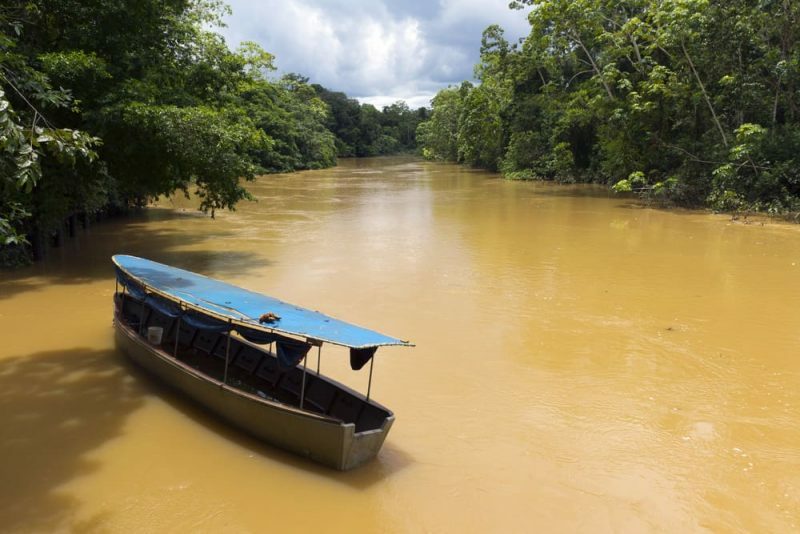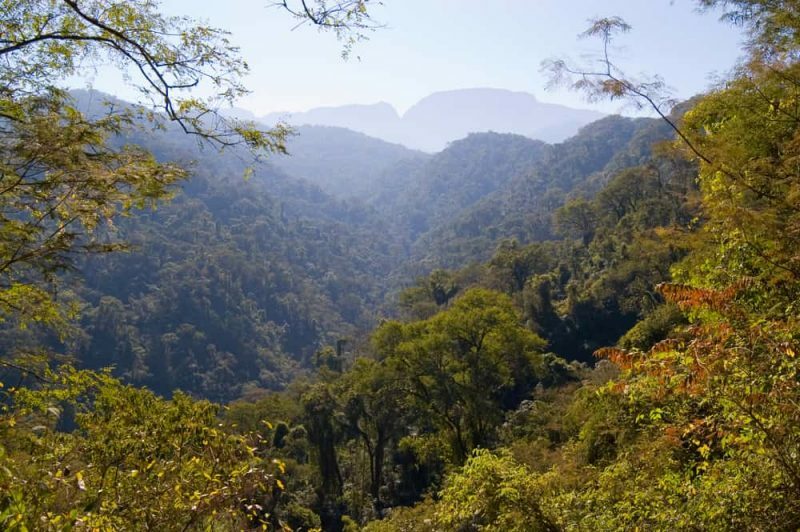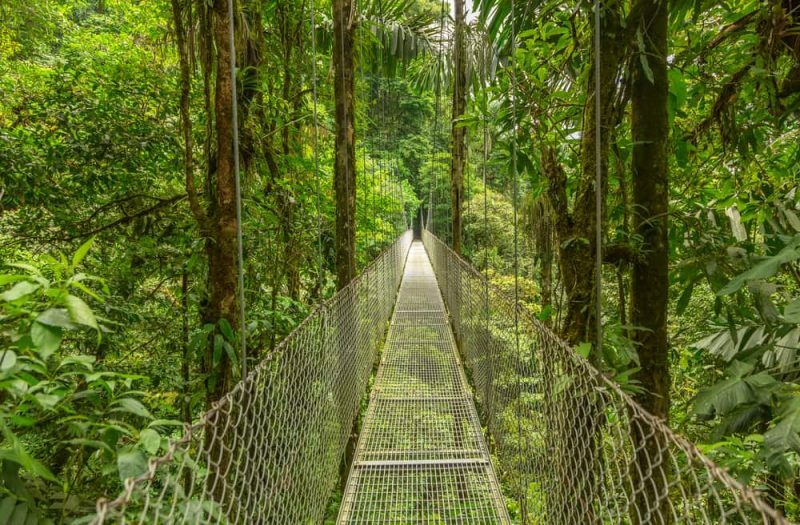20 Examples of Jungles
Miscellanea / / July 04, 2021
It is understood by jungle, as well as by jungle or by tropical rain forest, a zone of abundant vegetation with broad, leafy leaves, a closed canopy, and usually numerous levels of diverse understory (that is, several “floors” or “levels” of vegetation). For example: Congo jungle, missionary jungle, Borneo jungle.
The jungles are usually home to a huge amount of biomass (two-thirds of the whole world) and occur in regions of frequent and abundant rainfall, with soils rich in organic material and generally warm climates of the intertropical strip.
There is no established criterion to distinguish between rainforests, jungles and tropical forests, but they are often used to designate dense and impenetrable vegetation extensions, in contrast to temperate forests with greater distances between trees.
The jungles are considered today a huge biological terrain to discover, with the hope of giving, among its many species vegetables Y animals to discover, with some that allow us new pharmaceutical and medicinal advances.
Examples of jungles
- The Amazon. It is the largest forest in the world, with six million square kilometers of surface, distributed among nine countries: Brazil, Peru, Bolivia, Colombia, Venezuela, Suriname, Guyana, Ecuador and French Guyana. It is perhaps the ecoregion with the largest biodiversity of the planet and was declared in 2011 as one of the seven natural wonders of the world.

- Darien plug. This is the name given to the jungle area that marks the separation between Colombia and Panama, as well as between South America and Central America. Its name is due to the fact that the Pan-American Highway that unifies many of the countries of the continent is interrupted there, and there are no alternative land routes to cross the vegetation.
- Western guinean lowland rainforest. This rainforest of more than 200,000 km2 it extends from Guinea and Sierra Leone through Liberia, to the southwestern Ivory Coast. Few regions of Africa are as humid as this one, whose dry season is short but intense. Like the rest of the Guinean jungle, its state of conservation is critical.
- Guinean montane jungle. 31,000 km2 of rainforest scattered in the mountain chain of Guinea, Ivory Coast, Liberia and Sierra Leone occupy this region of West Africa. Despite its biotic importance, it is impossible to calculate its conservation status due to the continuous civil wars that have ravaged the region.
- Congo jungle. Stretching across the basin of the Congo River and its tributaries, this African rainforest encompasses an enormous expanse of territory, including territories of Gabon, Equatorial Guinea, Republic of the Congo, Cameroon and the Republic Central African. It is the second largest forest in the world (700,000 km2) and contains a wide and rich biodiversity in a current state of vulnerability due to deforestation, construction and poaching.

- Central Jungle of Peru. This forest occupies 10% of the territory of said country, and is exploited in coffee and cocoa crops, important export products of Peru, although the poverty margins in the population of the region are important.
- Nigerian lowland rainforest. Jungle umbrophilic (rain most of the year) of about 67,300 km2 stretching between Nigeria and Benin, currently critically endangered, with five endemic species of mammals threatened by the numerous populated and urbanized areas of the region.
- Missionary jungle. Occupying 35% of the territory of the province of Misiones, in the north of Argentina, this very humid jungle and lots of sun is one of the tourist attractions in the area, bordering between Brazil and Argentina. It extends along very low valleys and mountain ranges up to 850 meters above sea level.
- The yungas. Typical of the eastern flank of the Andean mountain range, the yungas are montane jungles or mountainous, cloud, rainy and tropical Andean forests. They extend from northern Peru to Bolivia and northern Argentina, and contain a fundamental biotic contribution to the diversity of species South American.

- Taman Negara. It is the name of a National Park and Malaysia's first protected area, it is one of the oldest tropical rainforests in the world, with an estimated 130 million years old. It is currently one of the main tourist attractions of this Asian nation.
- Jungle of New Guinea. The third most biodiverse forest in the world and one of the most extensive that exists, is located on the island of Nueva Guinea, occupying 85% of the total territory of the island, about 668,000 km2. It is considered one of the least intervened on the planet and comprises three jungle steps: tropical, equatorial and cloudy.
- Usambara mountain jungle. Located in Tanzania and part of the Eastern African Mountain Arch, a forest extends over the Usambara Mountains A long-standing tropical tree with a strong presence of endemic species, due to particular evolutionary conditions. It is currently under strong ecological threat, due to indiscriminate logging, and numerous global initiatives urgently seek to repair the damage done.
- Monteverde Cloud Forest. Chosen as one of the 7 tourist wonders of Costa Rica, it is a tropical forest of great biological importance, since it has 5% of the world's bird species, 6.5% of bats, 3% of butterflies and 3% of ferns.

- Sub-humid rainforest of Madagascar. Located in the plateau central African island of Madagascar, this rainforest of almost 200,000 km2 it receives the humid trade winds that maintain the ideal atmosphere for its exuberant vegetation. Currently, however, it is threatened by the growth of Antananarivo, the nation's capital, and the growing practice of farming itinerant.
- Lacandon jungle. Also called "Desert of Solitude", it is located in Chiapas, Mexico, towards the border with Guatemala, a region where the Lacandón Mayan people live. It comprises almost 960,000 hectares of humid jungle, and it gained a lot of notoriety in the 1990s with the appearance of the Zapatista Army of National Liberation.
- Borneo jungle. Located on the island of the same name, it occupies most of its territory, remaining largely virgin and unexplored. More than 400 new species of animals and plants have been discovered in it since 1994, despite the fact that The slash and burn, together with the monoculture of the palm tree to obtain oil, keep the forest under threat.
- Jungle of Petén. It is located in Guatemala, in the northern sector of the homonymous department, of which it occupies approximately 30%. Since the 1990s, UNESCO has joined forces with the Guatemalan State to preserve the rich biosphere it contains.

- Valdivian forest. Of almost 400,000 km2 thick, it is located in the border region of Chile with Argentina. It is a temperate rain forest, although it was formerly called jungle, currently preferred term for tropical vegetation. However, the term is still used for tourism and promotional purposes.
- Eastern guinean jungle. Located in southwestern Ivory Coast and Ghana, as well as Togo and Benin, it is a 184,000 km rainforest2. Despite the numerous endemic species of primates, reptiles Y amphibians, This forest is in critical danger, given the indiscriminate logging and hunting, product of agricultural use and the export of hardwoods.
- Humid jungle in the Farallones de Cali. Together with the tropical forest, cloud forest and paramo, the humid forest integrates the ecological zones of this rock formation in western Colombia. With trees up to 40 meters high, this jungle preserves the ideal climate for various rivers that supply electric power to the cities of Valle del Cauca.
Follow with:



